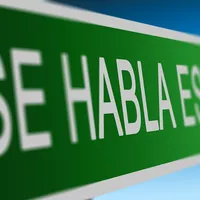B: Perdona... ¿sabes si hay alguna parada de taxis por aquí cerca?
B: Entschuldigung ... wissen Sie, ob es hier einen Taxistand in der Nähe gibt?
B: Excuse me... do you know if there is a cab stand nearby?
B: Excusez-moi ... savez-vous s'il y a des taxis à proximité?
B: Mi scusi... Sa se c'è una stazione di taxi nelle vicinanze?
B:申し訳ありません...近くにタクシー乗り場があるかご存知ですか?
B: Desculpe... Sabe se há alguma praça de táxis aqui perto?
B: Извините... Вы не знаете, есть ли поблизости стоянка такси?
B: Ursäkta ... vet du om det finns en taxistation nära här?
A: Pues yo no suelo coger el taxi, pero vaya, creo que no.
A: Nun, ich nehme normalerweise kein Taxi, aber ich glaube nicht.
A: Well I do not usually take the taxi, but go, I think not.
R : Je n'ai pas l'habitude de prendre le taxi, mais je ne pense pas que ce soit le cas.
R: Beh, di solito non prendo i taxi, ma non credo proprio.
A:ええと、私は通常はタクシーを利用しませんが、男の子はそうは思いません。
O: Cóż, zazwyczaj nie jeżdżę taksówkami, ale nie sądzę.
A: Bem, eu não costumo pegar o táxi, mas acho que não.
О: Обычно я не езжу на такси, но я так не думаю.
A: Tja, jag brukar inte ta en taxi, men hej, jag tror inte det.
A: Ồ, tôi không thường đi taxi, nhưng ồ, tôi không nghĩ vậy.
B: ¿Y sabes si pasan muchos taxis por aquí?
B: Und weißt du, ob hier viele Taxis fahren?
B: And do you know if a lot of taxis go by here?
B : Et savez-vous si beaucoup de taxis passent par ici ?
B: E sa se qui passano molti taxi?
B:そして、多くのタクシーがここを通過するかどうか知っていますか?
B: E sabe se passam muitos táxis por aqui?
B: А вы не знаете, много ли здесь проезжает такси?
B: Och vet du om det passerar många taxibilar här?
B: Và bạn có biết có nhiều xe taxi đi qua đây không?
Es que tengo prisa.
Ich habe es eilig.
I'm in a hurry.
Je suis pressé.
Ho fretta.
私は急いでね。
Estou com pressa.
Это я тороплюсь.
Jag har bråttom.
Tôi đang vội.
A: Esta calle es muy tranquila, mejor ve a la siguiente calle, es más grande y tiene más tráfico, por lo que suelen pasar más taxis.
A: Diese Straße ist sehr ruhig. Gehen Sie besser zur nächsten Straße. Sie ist größer und hat mehr Verkehr, sodass normalerweise mehr Taxis vorbeifahren.
A: This street is very quiet, better go to the next street, it is bigger and has more traffic, so more taxis tend to pass by.
R: Cette rue est très calme, mieux vaut aller dans la rue suivante, elle est plus grande et a plus de trafic, donc plus de taxis ont tendance à passer.
R: Questa strada è molto tranquilla, meglio andare nella strada successiva, è più grande e più trafficata, quindi passano più taxi.
A:この通りはとても静かです。次の通りに行くほうがいいです。もっと大きくて交通量も多いので、より多くのタクシーが通過する傾向があります。
R: Esta rua é muito sossegada, é melhor ir para a rua seguinte, que é maior e tem mais trânsito, por isso passam mais táxis.
A: Эта улица очень тихая, лучше идите на соседнюю улицу, она больше и на ней больше машин, поэтому такси обычно больше.
S: Den här gatan är väldigt tyst, det är bättre att gå till nästa gata, den är större och har mer trafik, så fler taxibilar tenderar att passera.
A: Con phố này rất yên tĩnh, tốt hơn nên đi sang con phố tiếp theo, nó lớn hơn và có nhiều xe cộ qua lại hơn nên thường có nhiều taxi đi qua hơn.
B: ¿Por aquí hacia arriba?
B: Hier oben?
B: Up here?
B: ici?
B: Da questa parte?
B:ここまで?
B: Por aqui?
Б: Сюда наверх?
B: Upp här?
B: Trên đây à?
乙:在這裡嗎?
A: No, la siguiente hacia abajo, es paralela a esta.
nein, die nächste nach unten, sie ist parallel dazu
A: No, the next one down, is parallel to this one.
R : Non, le suivant est parallèle à celui-ci.
R: No, quello successivo è parallelo a questo.
A:いいえ、次の問題はこの問題と並行しています。
R: Não, a seguinte é paralela a esta.
A: Нет, следующий вниз, он параллелен этому.
A: Nej, nästa ner är parallell med den här.
Đáp: Không, cái tiếp theo ở dưới song song với cái này.
A:不,下一個與這個是平行的。
B: Gracias.
B: Danke.
B: Thanks.
B : Merci.
B: Obrigada.
Б: Спасибо.
A: De nada.
A: Gern geschehen.
A: You're welcome.

